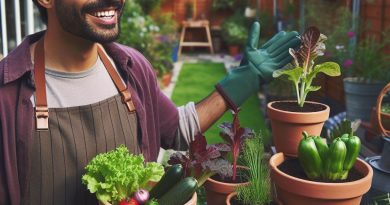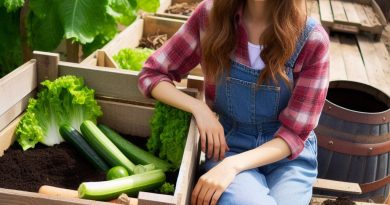Soil Aeration Techniques for Healthier Roots
Last Updated on February 9, 2024
Introduction
Healthy roots are fundamental to plant growth and play a crucial role in nutrient uptake, water absorption, and overall plant vigor.
A well-aerated soil serves as a catalyst in promoting root health and optimizing plant growth.
Aeration is the process of increasing the air circulation within the soil, which helps prevent compacting, improves oxygen availability, and ensures proper drainage.
These factors directly contribute to root development, ensuring healthier plants.
Adequate oxygen supply in the soil is essential for root growth as roots need oxygen to metabolize and convert stored nutrients into usable forms.
Insufficient oxygen can result in root suffocation, leading to stunted or weakened plants.
Furthermore, soil compaction can restrict root growth and penetration into deeper soil layers where vital nutrients are often found.
This can significantly impact a plant’s ability to absorb nutrients, resulting in nutrient deficiencies and decreased overall health.
Soil aeration techniques, such as mechanical aeration, can be employed to enhance root growth and overall plant health.
Mechanical aeration involves the use of specialized tools to create channels in the soil, allowing for improved air and water movement.
Another method of soil aeration is through the addition of organic matter, such as compost or peat moss, which can increase pore space and improve soil structure, promoting healthy root growth.
Tilling or loosening compacted soil can also aid in providing favorable conditions for roots.
Basically, healthy roots are vital for optimal plant growth, and soil aeration plays a significant role in promoting root health.
By ensuring proper aeration, roots can access essential oxygen and nutrients, leading to healthier and more productive plants.
Basics of Soil Aeration
Soil aeration is a fundamental practice for maintaining healthy roots and ensuring the successful growth and development of plants.
Understanding the basics of soil aeration, including its definition, the significance of oxygen for root growth, and the importance of proper soil aeration techniques, is essential for any gardener or landscaper.
Definition of soil aeration
Soil aeration is the process of increasing the oxygen levels in the soil.
It involves creating channels or spaces within the soil structure to allow for better air circulation and increased oxygen availability to the plant roots.
When the soil is well-aerated, roots can easily access the oxygen they need for respiration.
Significance of oxygen for root growth
Oxygen plays a critical role in root growth and overall plant health.
Roots require oxygen for respiration, which is the process by which they convert stored energy into usable forms for growth and maintenance.
Without proper oxygen levels, root metabolism slows down, leading to stunted growth and an increased susceptibility to diseases and pests.
In addition to respiration, oxygen is also necessary for nutrient uptake by the roots.
Adequate oxygen levels around the roots improve their ability to absorb essential nutrients, such as nitrogen, phosphorus, and potassium.
Without sufficient oxygen, the roots may struggle to absorb nutrients effectively, leading to nutrient deficiencies and adversely impacting plant growth.
Importance of proper soil aeration techniques
Using appropriate soil aeration techniques is crucial to ensure a healthy root zone and promote optimal plant growth.
Proper soil aeration:
- Facilitates proper root development: Adequate oxygen levels promote the formation of strong and healthy roots, which are essential for anchoring plants and absorbing water and nutrients.
- Enhances nutrient availability: Well-aerated soil allows roots to access and uptake nutrients more efficiently, leading to improved plant nutrition and overall health.
- Improves soil structure: Proper soil aeration helps prevent compaction and waterlogging, reducing the risk of root suffocation and disease development.
- Supports microbial activity: Beneficial soil microorganisms, including those responsible for nutrient cycling and disease suppression, require oxygen to thrive. Aeration enhances microbial activity, fostering a healthier soil ecosystem.
There are various soil aeration techniques to consider, such as:
- Mechanical aeration: This involves using tools like a garden fork or aerator to create small holes or channels in the soil, allowing for improved oxygen exchange.
- Natural aeration: Practices like avoiding excessive soil compaction, incorporating organic matter, and promoting earthworm activity can enhance natural soil aeration.
- Aeration through amendments: Adding organic materials, such as compost or peat moss, can improve soil structure and porosity, leading to better aeration.
- Cover cropping: Planting cover crops with deep root systems can help break up compacted soil and improve aeration.
In fact, soil aeration is essential for promoting healthy root growth and robust plants.
Understanding the basics of soil aeration, including its definition, the significance of oxygen, and the importance of proper techniques, allows gardeners and landscapers to create an optimal environment for plants to thrive.
By ensuring adequate oxygen levels and implementing suitable soil aeration practices, we can cultivate healthier roots, leading to more vigorous and productive plants.
Read: Fall Harvest Guide: Best Practices
Natural Soil Aeration Techniques
Achieving healthy roots is essential for the overall well-being and productivity of plants.
One crucial aspect in ensuring this is proper soil aeration, which facilitates the exchange of gases, water, and nutrients between the soil and the roots.
While there are various techniques available, natural methods are often preferred due to their sustainable and environmentally friendly nature.
Here, we will explore some of the natural soil aeration techniques:
Factors that naturally contribute to soil aeration
- Soil texture plays a vital role in natural soil aeration, with sandy soils being more porous.
- Well-structured soils, consisting of different-sized particles aggregated together, promote air circulation.
- Permeability, or the ability of soil to allow water to pass through easily, also aids in soil aeration.
- Presence of macro and microorganisms in the soil create tunnels and pores, improving aeration.
- Plant roots themselves contribute to soil aeration by releasing oxygen during respiration.
The role of earthworms in soil aeration
Earthworms, often referred to as nature’s plough, are outstanding contributors to natural soil aeration.
Their activities help in:
- Creating burrows and channels that enhance air movement and water drainage.
- Loosening the soil as they tunnel, allowing roots to penetrate easily and access nutrients.
- Breaking down organic matter, which enriches the soil and further promotes aeration.
- Burying organic residues, such as leaves, providing nourishment for beneficial soil organisms.
Encouraging earthworm activity in your garden or agricultural fields can significantly improve soil aeration and subsequent plant growth.
Importance of organic matter in promoting natural soil aeration
Organic matter, derived from plant and animal residues, greatly influences natural soil aeration.
The presence of organic matter results in:
- Improved soil structure, allowing for better air circulation and root development.
- Increase in soil’s water-holding capacity, preventing waterlogging, and enhancing aeration.
- Enhanced microbial activity, as organic matter serves as food for beneficial soil bacteria and fungi.
- The release of carbon dioxide during decomposition, which creates air pockets in the soil.
Adding compost, leaf litter, or other organic materials to the soil can provide a long-lasting aeration benefit.
In short, natural soil aeration techniques offer sustainable solutions for maintaining healthier roots.
Factors like soil texture, soil structure, and the presence of organisms contribute to natural aeration.
Earthworms, with their burrowing and organic matter breakdown activities, play a significant role in promoting aeration.
Additionally, the incorporation of organic matter into the soil further enhances its aeration properties.
By adopting these natural techniques, gardeners and farmers can ensure optimal soil conditions, leading to improved plant growth and productivity.
Read: Urban Farm Water-Saving: Top 5 Effective Methods
Mechanical Soil Aeration Techniques
A healthy root system is essential for the growth and development of plants.
Adequate aeration of the soil plays a crucial role in ensuring the roots receive sufficient oxygen for optimal growth.
Mechanical soil aeration techniques are effective methods used to improve soil aeration.
This section will provide an overview of these techniques, including tilling, the use of aerating tools and equipment, as well as their benefits and drawbacks.
Overview of Mechanical Soil Aeration Methods
- Mechanical soil aeration methods involve physically altering the soil structure to enhance aeration.
- These methods are typically used in compacted or heavy soils with poor natural aeration.
- There are various techniques available, each with its own advantages and limitations.
Tilling and Its Effect on Soil Aeration
Tilling is a popular mechanical soil aeration technique that involves breaking up the soil surface to improve aeration.
It can be done using manual or motorized tillers.
The main objective of tilling is to create channels or pores in the soil that allow air, water, and nutrients to penetrate more easily.
When soil is tilled, it helps to loosen compacted soil, allowing roots to grow more freely.
Tilling also disrupts weed growth and facilitates the incorporation of organic matter into the soil, further enhancing its overall fertility.
Use of Aerating Tools and Equipment
In addition to tilling, there are several specialized aerating tools and equipment available to improve soil aeration.
- Spiked shoes: These shoes have spikes on the soles that create holes in the soil as the wearer walks.
- Aerating forks: Fork-like tools with elongated tines that penetrate the soil, creating space for air and water.
- Aerating machines: Motorized machines equipped with rotating tines or blades that cultivate the soil, promoting aeration.
Benefits and Drawbacks of Mechanical Soil Aeration Techniques
While mechanical soil aeration techniques offer numerous benefits, they also come with certain drawbacks.
Benefits:
Improved soil structure: Mechanical aeration helps to break up compacted soil, creating a more favorable environment for root growth.
Better nutrient absorption: Enhanced soil aeration increases nutrient availability to plant roots, leading to improved nutrient uptake.
Increased water infiltration: Aeration techniques facilitate better water penetration, reducing surface runoff and improving water retention.
Drawbacks:
Potential soil disturbance: Excessive or improper tilling can disrupt the soil’s natural structure and negatively impact soil organisms.
Time and labor-intensive: Mechanical soil aeration techniques often require significant time, effort, and machinery.
Temporary results: The benefits of mechanical aeration may only last for a limited time before the soil reverts to its previous state.
In essence, mechanical soil aeration techniques, including tilling and the use of aerating tools and equipment, play a vital role in creating healthier roots.
While these techniques offer numerous benefits, it is essential to carefully consider their drawbacks and use them judiciously to maintain long-term soil health.
Read: Summer Garden Care: Beat the Heat!

Biological Soil Aeration Techniques
Introduction to biological soil aeration methods
- Biological soil aeration techniques involve utilizing living organisms to enhance soil oxygen levels.
- These methods promote healthier root growth and improve overall soil structure.
Importance of beneficial soil microbes
- Beneficial soil microbes play a crucial role in improving soil aeration.
- They break down organic matter, creating air spaces in the soil, allowing for enhanced oxygen diffusion.
- These microbes also release enzymes that can break down compacted soil, improving aeration.
Enhancing soil aeration through cover crops
- Planting cover crops is an excellent way to improve soil aeration.
- Cover crops have deep root systems that create channels in the soil, allowing for better air movement.
- This creates a more favorable environment for beneficial soil microbes to thrive.
Role of composting in improving soil structure and aeration
- Composting is another effective method to enhance soil aeration.
- Adding compost to the soil improves its structure by increasing organic matter content.
- Compost also improves soil porosity, allowing for better air circulation and drainage.
- The increased microbial activity in compost-amended soil further enhances soil aeration.
By incorporating these biological soil aeration techniques, gardeners and farmers can significantly improve the health and vitality of their plants’ roots.
This, in turn, leads to increased nutrient uptake, better water infiltration, and overall improved plant growth.
Cover crops, such as legumes or grasses, should be planted during fallow periods or between cash crops to maximize soil aeration benefits.
Their deep root systems help break up compacted soil layers and create pathways for oxygen movement.
In addition to cover crops, adding compost to the soil is highly beneficial.
Compost not only adds valuable nutrients but also improves soil structure and aeration.
The organic matter in compost binds together soil particles, creating aggregates that allow for better air circulation.
The presence of beneficial soil microbes is also crucial for enhancing soil aeration.
These microorganisms break down organic matter, releasing carbon dioxide and creating air spaces in the soil.
They also produce enzymes that can break down compacted soil, increasing aeration and facilitating root growth.
To promote the growth of beneficial soil microbes, it is important to provide them with a favorable environment.
This includes avoiding the use of harmful chemical pesticides and practicing organic gardening methods.
These methods encourage the proliferation of beneficial microbes, leading to improved soil aeration.
In general, biological soil aeration techniques offer sustainable and effective options for improving root health and soil structure.
By incorporating cover crops, composting, and promoting beneficial soil microbes, gardeners and farmers can create an optimal soil environment for healthy plant growth.
Read: Marigolds: More Than Just Pretty
Aerating Compacted Soils
Identifying signs of soil compaction
Soil compaction can have detrimental effects on plant growth and overall soil health.
Identifying signs of soil compaction is essential to address the problem.
Stunted plant growth, reduced yields, waterlogging, poor drainage, and erosion all indicate soil compaction issues.
Additionally, the presence of hard, compacted soil layers can confirm the problem.
Techniques for relieving soil compaction
Various techniques can be employed to relieve soil compaction.
One simple method is using a garden fork to pierce the compacted soil surface.
This action creates small holes, allowing air and water to penetrate deeper into the soil.
Core aeration is another effective technique.
It involves removing small plugs of soil from the ground to promote better air circulation and reduce compaction.
Deep tilling is a more intensive technique for breaking up compacted soil layers.
It involves using machinery or tools to loosen the soil, improving its structure and porosity.
This method is suitable for severe cases of compaction or when preparing the soil for new plantings.
The use of deep-rooted plants for aeration
In addition to mechanical methods, planting deep-rooted crops can help improve soil aeration.
Plants like radishes and sunflowers have long taproots that penetrate the soil, creating channels for air and water to reach deeper layers.
As these plants decay, their root channels remain, providing pathways for continued aeration.
Importance of regular soil testing before aeration
Before implementing any aeration technique, it is crucial to conduct regular soil testing.
Soil tests provide valuable information about pH levels, nutrient content, and compaction levels.
Knowing the compaction level helps determine the appropriate aeration technique to employ.
Soil testing also guides in selecting the right deep-rooted plants to improve soil structure and aeration.
In review, aerating compacted soils is vital for healthier root growth and improved plant performance.
By identifying signs of soil compaction and employing suitable aeration techniques, such as garden forking, core aeration, and deep tilling, soil structure and permeability can be enhanced.
Additionally, the use of deep-rooted plants further aids in breaking up compacted soil and promoting aeration.
Regular soil testing provides crucial information for effective aeration strategies.
Overall, proper soil aeration techniques contribute to healthier roots and better plant growth.
Tips for Effective Soil Aeration
Achieving healthier roots through proper soil aeration is essential for the overall success of your plants.
By understanding the timing, frequency, and precautions involved, you can optimize the aeration process to ensure optimal results.
Timing and Frequency of Soil Aeration
- Do not aerate wet soil as it can lead to compaction and disrupt the root structure.
- Timing is crucial – aim to aerate when the soil is moist but not overly saturated.
- Aerate your soil at least once a year, preferably before the growing season begins.
- For compacted or problematic soil, consider aerating twice a year, in spring and fall.
Considerations for Different Plant Types
Each plant has unique needs, and understanding these requirements is vital for effective soil aeration.
- Select the appropriate aeration technique based on your specific plants.
- Sandy soils with good drainage may require less frequent aeration compared to clay soils.
- For shallow-rooted plants, use caution to avoid damaging the delicate root systems.
- Deep-rooted plants benefit from deep soil aeration to promote their growth and development.
Precautions to Avoid Damage During Aeration Process
While soil aeration offers numerous benefits, it’s crucial to take precautions to prevent any possible damage.
- Before starting the aeration process, locate and mark any underground utilities to avoid accidents.
- Stay clear of sprinkler lines and irrigation systems to prevent potential damage.
- Ensure that the aeration equipment is properly adjusted to prevent unnecessary soil disturbance.
- Regularly inspect the equipment for any signs of wear or damage that may affect its performance.
- Avoid aerating near tree roots to protect their vital systems and prevent harm to the trees.
- Do not aerate in extreme weather conditions such as high temperatures or heavy rain.
Incorporating these tips into your soil aeration routine will significantly contribute to the health and vitality of your plants.
By considering the timing, frequency, and specific needs of different plant types, you can ensure proper root development and overall plant growth.
Additionally, taking precautions to prevent any damage during the aeration process will protect your existing landscaping elements and preserve a healthy, vibrant garden.
Remember, effective soil aeration is a key component in maintaining a thriving garden.
Take the time to understand the unique requirements of your plants, and follow these tips to achieve the best results.
Your hard work will be rewarded with stronger, healthier roots and a more robust garden overall.
Conclusion
Soil aeration stands as a cornerstone for cultivating thriving plants.
By enhancing the soil’s ability to exchange gases, particularly oxygen, it promotes robust root systems.
These roots, in turn, become more adept at absorbing water and nutrients, fueling the plant’s growth and resilience against stressors like drought or disease.
To capitalize on these benefits, it’s essential to actively integrate proper soil aeration practices into our gardening or farming routines.
Whether through mechanical means like tilling or natural processes like cover cropping, ensuring adequate aeration sets the stage for healthier plants and higher yields.
Looking ahead, the future of soil aeration holds exciting possibilities.
Researchers are exploring innovative techniques such as biochar incorporation or precision aeration methods to further optimize soil health.
These advancements not only promise increased productivity but also contribute to more sustainable agricultural practices, minimizing environmental impact while maximizing yields.
All in all, soil aeration is not just a fundamental aspect of plant care; it’s a pathway to a greener, more bountiful future.
By embracing proper aeration techniques today, we pave the way for a flourishing tomorrow.


